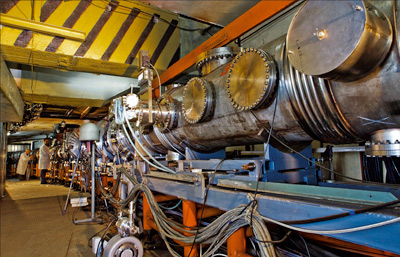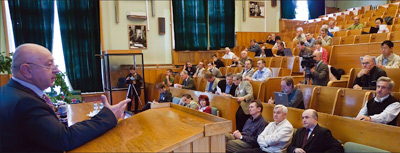A look at plans for a new superconducting accelerator complex at JINR.

Image credit: JINR.
Dynamic scientific projects with daring research programmes involving high technology can often trigger breakthroughs in innovation and industrial development. A team at the Joint Institute for Nuclear Research (JINR) at Dubna has conceived of one such project: the Nuclotron-based Ion Collider fAcility (NICA), a superconducting accelerator complex for colliding beams of heavy ions in the energy range of 4–11 GeV per nucleon in the centre of mass. It is this kind of project that is vital if Russia is to become a leader in innovation development.
The aim of NICA is to study an intricate and mysterious phenomenon: the mixed phase of quark–gluon matter. Conceived by the research group led by Alexei Sissakian, head of the NICA project, the facility is based on the Nuclotron, the superconducting ion synchrotron that already operates at JINR’s Veksler and Baldin Laboratory of High-Energy Physics. This latest project builds on the scientific schools and traditions of the scientists who founded this international centre for research in nuclear physics on Russian territory. The result is a collaboration between physicists at Dubna and other Russian scientific centres: the Institute for Nuclear Research of the Russian Academy of Sciences (RAS); the State Scientific Centre; the Institute for High-Energy Physics (IHEP) in Protvino; the Budker Institute of Nuclear Physics (BINP); the Scientific Research Institute for Nuclear Physics of Moscow State University; and the Institute for Theoretical and Experimental Physics in Moscow.
New lease of life
The NICA project has been under development since 2006, in close co-operation with leading institutions of the RAS, the Rosatom State Atomic Energy Corporation, the Federal Agency for Science and Innovation, the Federal Agency for Education, Moscow State University and the Russian Scientific Centre “Kurchatov Institute”. It will culminate in a unique accelerator complex – a cascade of four accelerators that includes the existing Nuclotron – which should be completed by 2015. Constructed at JINR with much effort and hardship in the period of change in Russia during the 1990s, the Nuclotron has been useful for world science but owing to insufficient financing, this superconducting accelerator has not achieved the planned beam parameters. The capacity of the vacuum and cryogenic equipment that was affordable a decade ago did not allow further energy increases. Today, however, the NICA project is breathing new life into the Nuclotron and has opened up new prospects for high-energy physics.
Studying the properties of nuclear matter is the fundamental task for modern high-energy physicists, with experimental research conducted at an extremely small scale – around a millionth of a nanometre. Achieving this task not only opens new horizons in perceptions of the world and enables researchers to decipher the evolution of the universe, it also lays the foundation for the development of new techniques on the super-small scale.

Image credit: JINR.
According to modern ideas, quark–gluon matter has a mixed phase – like boiling water that exists simultaneously with vapour. The mixed phase of hadronic matter should include free quarks and gluons simultaneously with protons and neutrons, inside which quarks are already constrained – or “glued” – by gluons. In the phase diagram of temperature and baryon density, the border between the hadronic state and quark–gluon plasma is not a thin line but a domain the size and shape of which is still difficult to determine. It is here, in what we call “the Dubna meadow”, where the mixed phase of hadron matter should exist.
NICA begins with the heavy-ion source, KRION, which propels nuclei into the linear accelerator that will be constructed by specialists from IHEP in Protvino. The beam then enters the booster-synchrotron, where particles are accelerated to the required energy. Thirty-four bunches, each consisting of 10,000 million nuclei, are transported into the Nuclotron. Once aligned by the superconducting magnets to form a thin thread approximately 30 cm long, they are split into two colliding beams of 17 bunches, each with its own ring in the 251-m circumference ion collider.
These two collider rings intersect at two points equipped with detectors. At one collision point, the MultiPurpose Detector (MPD) will detect the existence of the mixed phase and a number of other features in this energy range, such as chiral-symmetry restoration, critical phenomena and the modification of hadron properties in the hot, dense quark–hadron medium. The MPD is designed to spot particles that shoot out from the collision point in every direction. It will be necessary to apply mainly new technological approaches to develop a device with a sufficiently high level of sensitivity. Another detector is planned for the spin programme – the Spin Physics Detector (SPD) – which will be located at the second collision point. Particle polarization is another mystery of the universe, which Dubna’s theoreticians hope to unravel through experiments for NICA that have been designed together with specialists from BINP in Novosibirsk, who are pioneers in colliding-beam-accelerator technology.
The upgrade of the Nuclotron in Dubna is fully underway. The vacuum in the ring has been improved and the cryogenic complex – the heart of the superconducting accelerator – has been completely upgraded, as well as the power system. Modern diagnostic equipment is currently being installed and a new ion source is under development. The technical project for the NICA accelerator complex and the project concept are being developed at the same time.
Several groups of high-quality specialists from different JINR laboratories work in the NICA/MPD centre, where they are implementing the project for the new accelerator complex and experimental facilities. These include theoreticians, computer programmers, accelerator technologists, co-ordinators and experimentalists. Alexander Sorin, co-supervisor of the NICA project, is the centre’s general leader. Igor Meshkov heads the activities on the development of the accelerator complex and his former student, Grigory Trubnikov, now deputy-chief engineer of JINR, is leading the Nuclotron upgrade. Vladimir Kekelidze, the director of the Laboratory of High-Energy Physics, heads the team designing the MPD.
The construction of any modern experimental facility is impossible without detailed technical planning, so JINR has sought to involve the best-qualified engineers and designers in the process. Nikolai Topilin has returned to Dubna from CERN – where he was responsible for the development of the front-end calorimetry for the ATLAS experiment at the LHC – as chief designer of the NICA complex. It is a good sign for Dubna that engineering designers are returning, having left for the West when Russian science was in decline. Their high-level abilities have always been – and still are – in demand in western countries, so the fact that physicists and engineers are returning to Dubna shows that JINR has chosen the right way forwards.
The development of an accelerator is always linked with the course of events elsewhere, so the physics programme for such a facility and the concept of its construction elements are dynamically interrelated from the outset of the erection of this large-scale machine. The NICA project’s White Book, published in spring 2009, contains the physics basis of the experimental programme at the accelerator complex. It is constantly being replenished with new pages and is open to everyone wanting to contribute to the project.
Because Dubna is an integral part of the worldwide scientific community, the research and quality of the facilities must be of the highest level for it to attract partners. On 9–12 September 2009, the Laboratory of Theoretical Physics held the fourth round-table discussion on the programme, “Physics at the NICA Collider”, with 82 experts in heavy-ion physics from leading nuclear centres in 16 countries (including six JINR member states and four JINR associate members) invited to take part. Representatives from experimental collaborations of leading large facilities for similar research – JINR’s friends and scientific rivals – also showed interest in the programme for NICA, including RHIC at Brookhaven in the US, the Super Proton Synchrotron at CERN and the future Facility for Antiproton and Ion Research (FAIR) at GSI in Germany. The delegation from Germany was the largest, with nine experts, including Boris Sharkov, director-designate of FAIR, and Peter Senger, leader of the Compressed Baryonic Matter collaboration at FAIR.
The specifications of the NICA collider formed the main topic of discussion. Experts analysed the main aspects: nuclear-matter research in experiments with relativistic heavy-ion collisions; new states of nuclear matter at high baryonic densities; local P- and CP-violation in hot nuclear matter (the chiral magnetic effect); electromagnetic interactions and restoration of the chiral symmetry; mechanisms of multiparticle production; correlation femtoscopy and fluctuations; and polarization effects and spin physics at the NICA accelerator. Participants also discussed details of the strategy to develop the MPD and the SPD, based on the physics programme. Representatives from institutes in Russia and elsewhere took an active part in developing the programme. Russian scientists working abroad, including those originally from Dubna, proved to be eager supporters of the NICA project – for example, Brookhaven was represented by the leader of the Nuclear Theory Group, Dmitri Kharzeev.
In summary, there have been considerable qualitative evaluations at the level of world scientific expertise of the expediency and feasibility of the NICA project. “We strongly support the implementation of the NICA collider project and we are sure that if the project is completed in time it will make an outstanding contribution to our knowledge about the properties of the superdense matter…The unique opportunity to put the NICA project into action in Dubna must not be missed,” reads the joint memorandum on the results of the round-table discussions.
The coming year will see further contributions from Dubna to the scene of heavy ions. A new scientific journal, Heavy Ion, will accompany the research in heavy-ion physics at JINR, with the first issue scheduled for this year. On 23–29 August Dubna will take the baton from Brookhaven when it hosts an important international conference on heavy-ion collisions at high energies, the “6th International Workshop on Critical Point and Onset of Deconfinement”.








